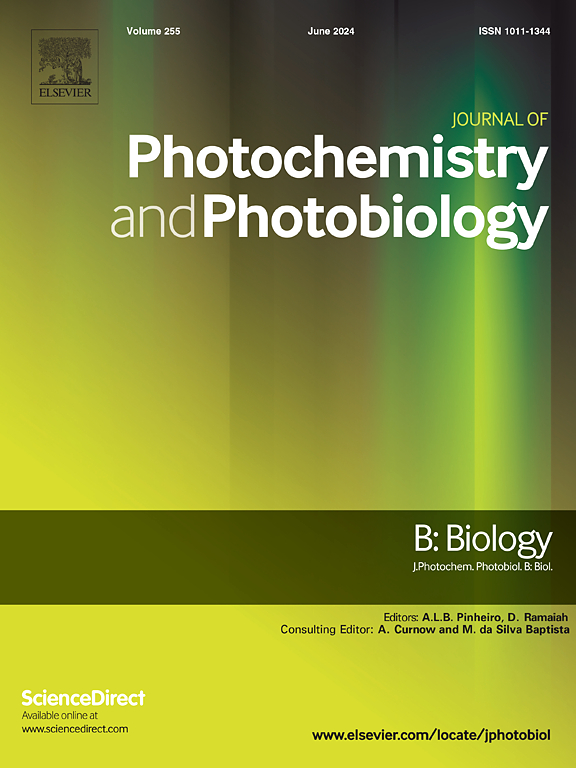Skin safety of 233 nm far UV-C ex vivo and in vivo – Pilot study for evaluating different populations and multiple exposures
IF 3.7
2区 生物学
Q2 BIOCHEMISTRY & MOLECULAR BIOLOGY
Journal of photochemistry and photobiology. B, Biology
Pub Date : 2025-09-05
DOI:10.1016/j.jphotobiol.2025.113262
引用次数: 0
Abstract
Nosocomial infections remain a major healthcare challenge, underlining the demand for antimicrobial technologies. Far UV-C (200–235 nm) has emerged as a safer alternative to traditional 254 nm UV-C for microbial reduction on skin and wounds but also in occupied spaces due to its strong germicidal properties and minimal skin penetration. However, studies on humans remain limited.
This study aimed at evaluating the skin safety of 233 nm UV-C for potential applications in antisepsis and public area decontamination. Ex vivo experiments first assessed age-dependent DNA damage before proceeding to in vivo studies. Healthy volunteers of varying skin types and ages underwent single exposures to evaluate the effects of age and pigmentation. Additionally, young and light-skinned volunteers received multiple exposures. Biopsies were collected to assess DNA damage and repair.
A biocidal dose of 233 nm induced superficial DNA damage, showing lower damage than that induced by suberythemal UV-B exposure, a recognized safe dose for human skin. Older and dark-skinned participants exhibited higher residual DNA damage 24 h-post-exposure compared to younger and lighter-skinned individuals, though nearly complete repair was observed after seven days. Repeated exposures, up to cumulative doses of 120 mJ/cm2 and 240 mJ/cm2, did not induce significant changes on skin pigmentation, antioxidant activity, or immune response. However, DNA damage accumulation suggested limitations in repair mechanisms over 24 h. These results confirm the safety of a single exposure to 233 nm, but highlight potential risks with repeated applications, emphasizing the need for careful dose regulation and further in vivo studies, including well-established treatments at 222 nm.
233nm远紫外- c的体外和体内皮肤安全性——评估不同人群和多次暴露的初步研究
医院感染仍然是一个主要的卫生保健挑战,强调了对抗菌技术的需求。远紫外线- c (200-235 nm)已成为传统254 nm紫外线- c更安全的替代品,用于皮肤和伤口上的微生物减少,但由于其强大的杀菌性能和最小的皮肤穿透性,也适用于占用空间。然而,对人类的研究仍然有限。本研究旨在评估233nm UV-C在防腐和公共场所去污方面的潜在应用。在进行体内研究之前,体外实验首先评估了年龄依赖性DNA损伤。不同皮肤类型和年龄的健康志愿者接受了单次暴露,以评估年龄和色素沉着的影响。此外,年轻和浅肤色的志愿者接受了多次接触。收集活检来评估DNA损伤和修复。233nm的生物杀灭剂剂量可诱导浅表DNA损伤,其损伤程度低于暴露于红斑下UV-B(公认的人体皮肤安全剂量)所造成的损伤。与年轻和皮肤较浅的人相比,年龄较大和皮肤黝黑的参与者在暴露24小时后表现出更高的残留DNA损伤,尽管在7天后观察到几乎完全修复。重复暴露,累积剂量达到120 mJ/cm2和240 mJ/cm2,不会引起皮肤色素沉着、抗氧化活性或免疫反应的显著变化。然而,DNA损伤积累表明修复机制在24小时内的局限性。这些结果证实了单次暴露于233 nm的安全性,但强调了重复应用的潜在风险,强调需要仔细调节剂量和进一步的体内研究,包括222 nm的成熟治疗。
本文章由计算机程序翻译,如有差异,请以英文原文为准。
求助全文
约1分钟内获得全文
求助全文
来源期刊
CiteScore
12.10
自引率
1.90%
发文量
161
审稿时长
37 days
期刊介绍:
The Journal of Photochemistry and Photobiology B: Biology provides a forum for the publication of papers relating to the various aspects of photobiology, as well as a means for communication in this multidisciplinary field.
The scope includes:
- Bioluminescence
- Chronobiology
- DNA repair
- Environmental photobiology
- Nanotechnology in photobiology
- Photocarcinogenesis
- Photochemistry of biomolecules
- Photodynamic therapy
- Photomedicine
- Photomorphogenesis
- Photomovement
- Photoreception
- Photosensitization
- Photosynthesis
- Phototechnology
- Spectroscopy of biological systems
- UV and visible radiation effects and vision.

 求助内容:
求助内容: 应助结果提醒方式:
应助结果提醒方式:


